A complete buyers guide to commercial fridges
From refrigerated cabinets and counters to blast chillers and saladettes, commercial refrigeration is intrinsic to the success of a kitchen – given its function of both keeping food fresh and free from bacteria.
However, it can also be one of the most energy-intensive elements of a kitchen. Unlike ovens or hobs, it is very rare for commercial refrigeration equipment to be switched off or put on standby. As such, if the efficiency of a product is not closely monitored, the running costs can quickly mount up and start to affect the finances of the organisation in question.
Given the breadth of product covered by commercial refrigeration equipment for the professional kitchen, this guide will cover:
- How to choose the right product for each application
- What equipment is available
- How to look after it.
How to choose commercial refrigeration equipment
With such a broad range of products falling in to the commercial refrigeration category, adopting a one-size-fits all approach to specification is not likely to result in the most appropriate fridge or freezer being chosen. We would always recommend an application-specific approach to finding the right refrigeration solution, however there are some important factors to bear in mind which are common across all types of equipment.
Capacity
It goes without saying that the chief function of a commercial fridge or freezer is to keep produce at a desired temperature – be it cool or frozen. For this to work effectively, there needs to be sufficient capacity within the unit to accommodate the desired volume of produce, and allow sufficient airflow around the product to maintain the required temperature. Overload the fridge, and air will not be able to circulate and the food in question is at risk of not being cool enough to retain its freshness, and could spoil much faster than anticipated.
Given variations in temperature are regularly deemed as the main cause of food spoilage in a professional kitchen, Electrolux Professional refrigeration equipment employs Optiflow intelligent air circulation system, to maintain a constant interior temperature no matter how many times the door is opened and closed.
Size
Refrigeration equipment is ever-present in the professional kitchen, and it should always be factored in where possible during the design stage to ensure adequate space is available. Thankfully, refrigeration is also one of the most versatile kitchen equipment product categories, and is available in a number of different styles – from stand-alone cabinets to under counter units and refrigerated drawers built-in to cooking suits – to ensure that, regardless of kitchen footprint, there is a commercial refrigeration system to suit.
Efficiency
Refrigeration is perhaps the only category where equipment is expected to run for 24 hours a day, seven days a week. In fact, it accounts for nearly a third of energy consumption within a commercial kitchen, which means the efficiency of refrigeration equipment plays a highly important role in the purchasing process.
Ultimately, the higher the efficiency rating of a fridge, the cheaper it is to run. As such, focusing on the total life cost of a fridge or freezer, rather than its net purchase price, is likely to lead to a more successful purchase.
The efficiency of commercial refrigeration equipment can be categorised in two different ways:
1) Energy labels
Energy labelling for refrigeration equipment was introduced by the European Commission as part of its Ecodesign Directive as of 1st July 2016. It sets out Minimum Energy Performance standards (MEPs) for commercial refrigeration equipment and all new products entering the market are categorised with an A-G rating based on energy efficiency, with A being the most efficient, and G the least.
However, it is very important that refrigeration equipment is not purchased solely on its energy label. For example, a light-duty Grade A fridge may actually be less efficient than a heavy-duty Grade D appliance, depending on where it will be used. To put the issue into context, a light-duty fridge isn’t too far away from a domestic model, so whilst it will have a lower value, it would not be suitable for most commercial kitchens over a certain size.
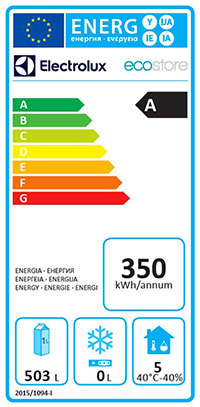
1) Energy labels
Energy labelling for refrigeration equipment was introduced by the European Commission as part of its Ecodesign Directive as of 1st July 2016. It sets out Minimum Energy Performance standards (MEPs) for commercial refrigeration equipment and all new products entering the market are categorised with an A-G rating based on energy efficiency, with A being the most efficient, and G the least.
However, it is very important that refrigeration equipment is not purchased solely on its energy label. For example, a light-duty Grade A fridge may actually be less efficient than a heavy-duty Grade D appliance, depending on where it will be used. To put the issue into context, a light-duty fridge isn’t too far away from a domestic model, so whilst it will have a lower value, it would not be suitable for most commercial kitchens over a certain size.
A such, customers need to pay just as much attention to the duty class as they do to the A-G rating. However, this is where a close working relationship between the manufacturer and specifier can ensure that customers ultimately end up with the most effective and appropriate solution for them
2) Climate Class
A fridge’s Climate Class denotes the operating temperature range for a particular application. For example, Climate Class 4 is recommended for operating conditions in excess of 30˚C and could be classed as medium duty. However, given the intense nature of a commercial kitchen, it is advised to consider Climate Class 5, which covers efficient operation in temperatures which consistently reach 40˚C and above.

Other factors such as construction material, refrigerant type, and insulation can all contribute to a unit’s efficiency rating. It’s also worth noting that the latest high efficiency fridges are likely to carry lower end-of-life disposal costs than models with a lower efficiency rating, so a bit of planning early on can save money right the way through the life cycle of the equipment.
What are the main types of commercial refrigeration?
Commercial refrigeration equipment is available in a variety of different shapes and sizes, to ensure professional kitchens can choose a product solution tailored to the available space, and volume of covers they are catering for each day.
Here are some of the most popular commercial refrigeration options suitable for the professional kitchen:
Refrigerated Cabinets
Upright refrigerated cabinets are one of the most recognisable pieces of commercial refrigeration equipment for chefs. Offering exceptional capacity with very low footprint, they offer flexible configuration with movable shelves to allow for evolving menus and regularly changing produce. Double-door models can provide even more capacity for kitchens with a high turnover of covers.
The Prostore 500 and 800 ranges of fridges consume 55 per cent less energy than standard cabinets, which lowers running costs in kitchens and dramatically reduces environmental impact.
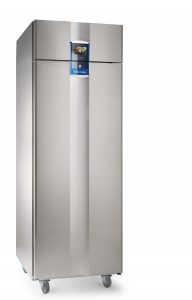
The range is supplied with a ‘green gas’ refrigerant, resulting in lower running costs and a reduced impact on the environment. R290 refrigerant gas is a natural refrigerant (Hydrocarbon) which is also far more energy efficient than comparable gases and reduces energy consumption by approximately 12 per cent.
Electrolux Professional’s ecostore range of refrigerated upright cabinets offers operators increased capacity of 50 litres more than the average competitor and best in class energy efficiency. With chrome finish and touchscreen technology, the range is available with a solid door, glass door, two x 1/2 doors (with or without dual temperature), two full doors (with or without dual temperature) or two glass doors.
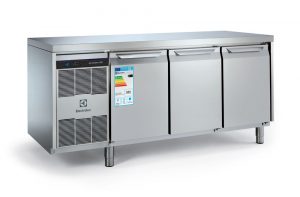
Refrigerated counters
For kitchens tight on floorspace, making use of refrigerated counters – either on their own or paired with an upright refrigerated cabinet – is an effective way of maximising available footprint, as the top of the unit can double-up as work space for the preparation of ingredients.
Combing A-rated efficiency with Climate Class 5, the new ecostoreHP range of refrigerated counters from Electrolux Professional has the potential to save up to £400 per year*; ultimately delivering greater profitability and a fast return on investment.
The ecostoreHP counter boasts 50 litres greater storage capacity than the industry average, which effectively means that for every four of these fridges, a large kitchen would need five competitor models. Units can be customised to incorporate refrigerated drawers depending on the desired configuration.
Given kitchens have a tendency to pose their own logistical challenges at times, the ventilation unit has been located at the front of the fridge, to make installation as simple as possible and avoid the need for clearance space.
*potential energy saving based on EU legislation labelling obtained by comparing class G refrigerated counters with equivalent in class A (with EU average energy cost of £0.18/kWh and net volume of 310l)
Refrigeration tables
Offering an alternate solution to refrigerated cabinets, table configurations allow chefs to store ingredients in chilled easy-to-access chilled compartments above the work surface, as well as in refrigerated cabinets or drawers underneath the counter. The Electrolux Professional Saladette range is available in a variety of configurations, including AISI 304 stainless steel or marble top, as well wheel-mounted or free-standing options – to give complete flexibility to chefs looking for a compact and multi-functional commercial refrigeration solution.
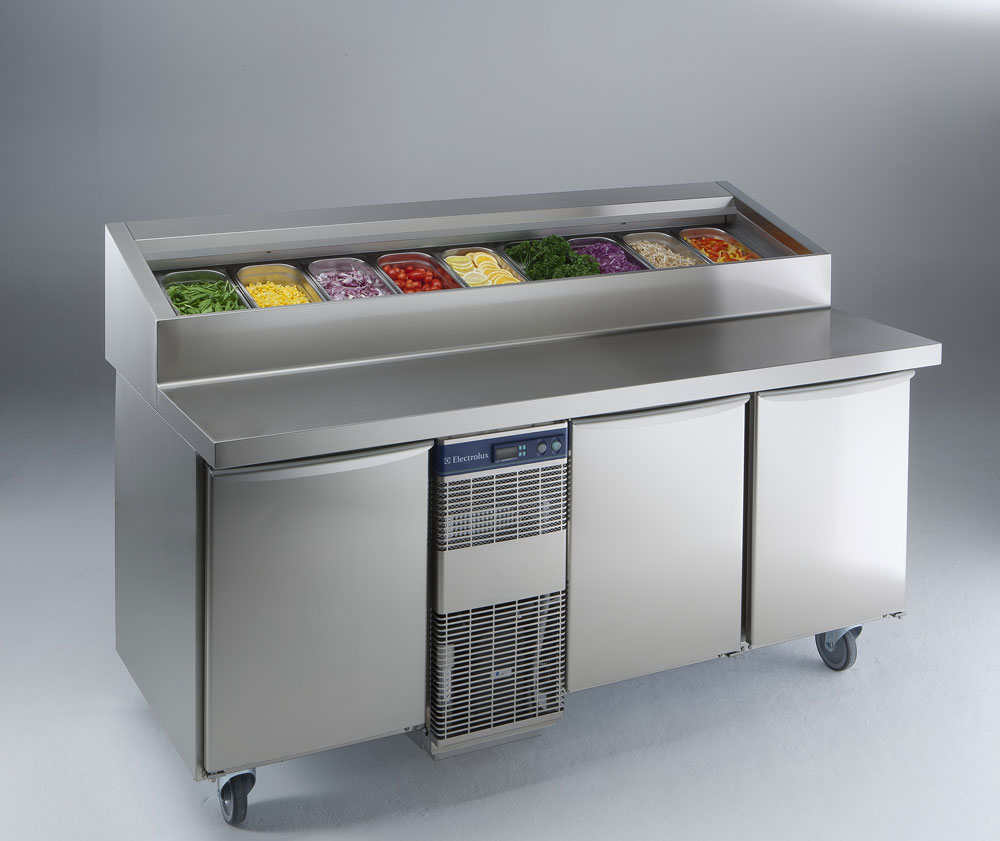
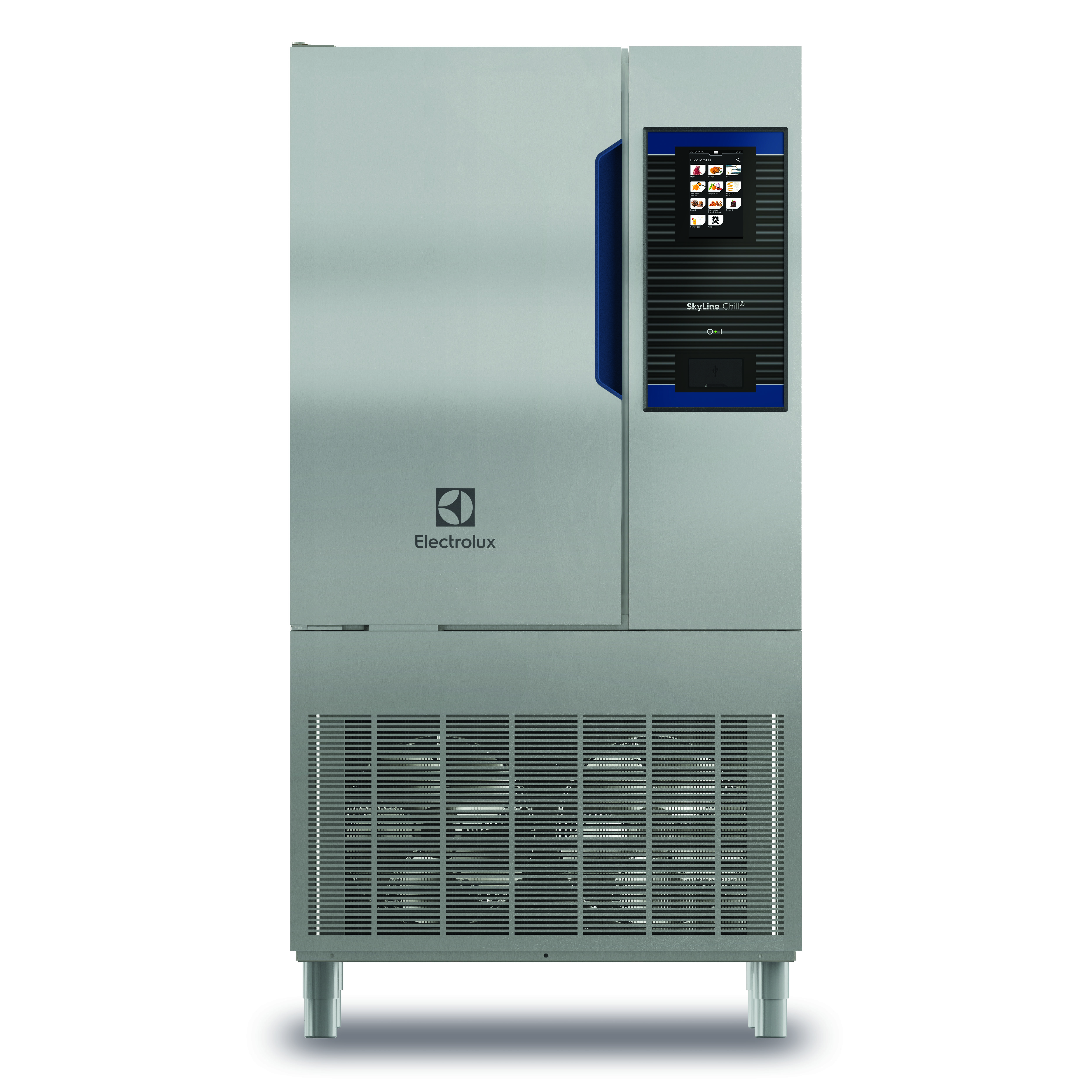
Blast chillers
Blast chillers are one of the cornerstones of the modern kitchen. They allow food to be taken directly from an oven and quickly chilled to prevent further cooking and ensure the ingredients retain the desired taste and texture, before being reheated at a later time. For kitchens which supply a significant volume of covers, or those which may be used for banqueting events, blast chillers and an invaluable item of commercial refrigeration. What’s more, they are also essential to the preparation of a variety of desserts, and can often be found in several different areas of a kitchen.
The air-o-chill blast chillers and freezers from Electrolux Professional can be configured to sit directly underneath a combi oven – known as the Cook&Chill concept – to optimise kitchen workflow and minimise the time food is out in the open.
Quality build materials are essential to a successful and long-lasting blast chiller. All Electrolux Professional models aren’t just tested in lab conditions, they’re tested in higher temperature and higher humidity conditions as well. A simulation programme is also employed to replicate the projected lifetime usage so we know that when that piece of equipment is delivered to a customer’s premises, it will deliver not only efficient, but long-lasting levels of performance.
How to maintain your commercial refrigeration for long-lasting performance
Failing to properly look after your commercial refrigeration equipment post-purchase is a sure-fire way of undermining all the time spent identifying the most appropriate solution during the original specification process. From pre-sale product training through to on-going maintenance, there are a few easy-to-adopt practices that will go a long way to ensuring your refrigeration equipment will continue to operate effectively and efficiently throughout its operational life.
Keep it clean
Fridges and freezers are subject to a high level of product turnover, and even though most kitchens will employ specific processes to ensure similar produce will be stored together, there is every chance some small residue or left-over leaves can remain after the food has gone. While the importance of the deep clean is ingrained into most chefs from an early age, given its ‘always on’ nature and the perceived hassle of switching commercial refrigeration off, it can sometimes be overlooked. The most effective approach should be little and often, to ensure that each ingredient is properly packaged and, when removed, any remaining traces are quickly dealt with. Sanitising and degreasing sprays are readily available to help keep on top of refrigeration hygiene, and the use of reusable containers and trays – which can be put through a commercial dishwasher – can also aid the cleaning process.
All Electrolux Professional models feature removable door seals, which can be quickly removed, cleaned and reapplied in a matter of seconds, to minimise areas where bacteria can hide.
Maintain best practice
The UK professional catering industry can at times be guilty of letting equipment run to failure. Failing to identify early warning signs with your commercial refrigeration equipment and dealing with them right away can significantly impact the total life cost of the unit.
Implementing a planned preventative maintenance (PPM) programme can go a long way to tackling any small issues, such as door sealing or overheating ventilation systems, before they become unrepairable. Many equipment manufacturers, including Electrolux Professional, offer such contracts as part of aftersales support packages.
Warranties
Warranties are a clear display of a manufacturer’s faith in their equipment, and should not be overlooked during the purchasing stage. However, warranty length is only part of the story and customers should take care to ensure they are aware of any limitations or exclusions. It can sometimes be the case that the longer the warranty is, the greater the need to study the detail.
The Electrolux Professional standard warranty is two years, which includes parts and labour. Specific warranty policies can be tailored to best fit business needs, and extended warranty contracts are also available across the commercial refrigeration product portfolio.
Spares & Repairs
As with any piece of professional kitchen equipment, refrigeration units can occasionally break down unexpectedly. Given the financial impact this could have on a kitchen, ensuring a replacement is immediately available can go a long way towards minimising the impact of refrigeration downtime.
The Electrolux Express range is made up of a selection of the most commonly replaced commercial refrigeration equipment. That means if a fridge or freezer were to break down, businesses can get hold of a replacement the very next day – with flexible finance options also available for those who don’t have the necessary capital to replace kit straight away.
Final thoughts
Ultimately, commercial refrigeration equipment is situated right at the heart of the professional kitchen. It is essential to not only keeping produce fresh, but also to keeping overheads to a minimum. Choosing new equipment should not be rushed, and the specification process should encompass a variety of key factors, from capacity to Climate Class, before a decision is made. Electrolux Professional offers an extensive range of refrigeration solutions, and is on hand to help chefs of all sectors chose the right product for them.
